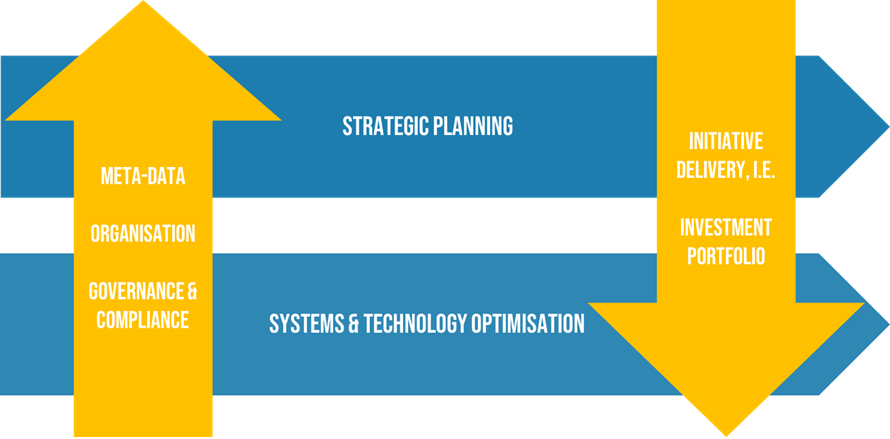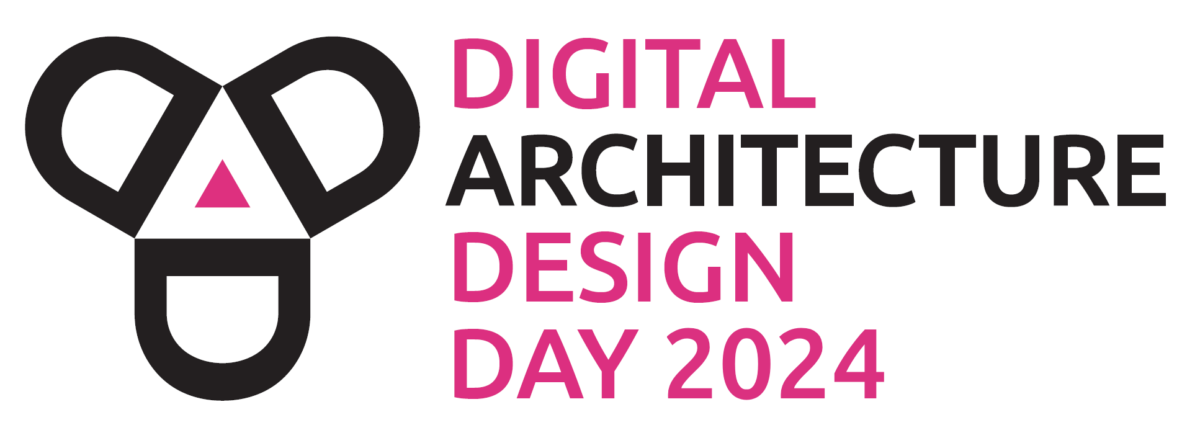The modern interpretation of Enterprise Architecture (EA) follows the perspectives of strategy to execution and directing the change “from concept to plan”.
The modern interpretation of Enterprise Architecture (EA) follows the perspectives of strategy to execution and directing the change “from concept to plan”.
Enterprise Architecture (EA) is the most holistic and strategic one of the architecture disciplines, the long-term perspectives where strategic planning and rationalisation of systems and technologies are being addressed.
The owner of the Enterprise Architecture function is typically the Chief Architect, a senior person that together with other architecture leads will ensure the responsibility to make recommendations at portfolio level by simultaneously maintaining all the relevant metadata in an EA repository with fresh data.
The overall objectives are among others:
- To ensure a sound balance in the future investments among the strategic objectives and other tactical objectives,
- To ensure the holistic perspectives that strategic goals support re-use of standards, patterns, reference targets and efficiencies
- Ensure the balance between current and future landscapes that favour innovation and reduction of older systems/technologies.
Hence, the modern EA function facilitates the “direction” in a tight coupling with other portfolio offices, primarily the demand management office (DMO) and project portfolio office (PMO), but also working closely together with other architecture roles which are more tactical and detail-focused, such as business architects, solution architects, domain architects, IT-architects.
Gartner speaks about “business outcomes”; that is the value that people recognize from the review and recommendations to adjust initiatives and projects to meet changes in the market and business with long-term sustainable direction. In other words, the EA function is measured by the ability to keep the direction to strategic objectives rather than to produce project deliveries.
The “alignment to strategy” is often seen as the key outcome. Alignment can be measured in terms of the different outcomes delivered by the directed portfolio of investments, by the number of new systems and technologies, and the withdrawal of costly and old technologies.
Enterprise Architecture bridges both the business side and systems/technology side. If you consider banks, insurance companies and online services, IT is often an integrated way of doing business so there is in most sectors no way you can talk about IT and business without seeing them as one overall entity where offerings constantly drift towards more digital interaction, more tech enabled. It is in this turnaround that the practice of Enterprise Architecture Management (EAM) should be seen, as the enabler to ensure a long-term thinking to the direction of investments, often catalysed and working closely with demand management office (DMO) and project management office (PMO) to ensure fuel to the planning.
At one hand this requires the understanding of current versus target solutions, but at the other hand, it also requires a future perspective into emerging technologies that can be utilized in the future digital offerings. Hence we often conceptualise the EAM as the four overall practices:
- The Strategic Alignment that ensures long-term objectives and tactical considerations are prioritised in the balance of initiatives.
- The Investment practice that ensures ideas get funneled into initiatives and demands to allow better planning, before handling over to solution delivery.
- The Systems and Technology optimisation that ensures the bottom-up improvements as input the to the investment process, this includes processes such as APM and TIME at the application level.
- The Governance and Metadata-management that ensures better terms, alignment on terms, governance and democratised updates in the EAM portal.
To succeed with EAM, we see the strategic alignment involves primarily business architecture, the investment process primarily enterprise and solution architects, the systems and technology optimisation the application, integration and technology architects, where as the governance and metadata is a classical EAM discipline to overview the portfolios and terms. Only by having guidance to the business change will it be possible to address the future offerings in a planning perspective, and not when the competitors have adopted it first.
A typical standard visual by the EAM function to be produced and maintained is a Business Capability Map. Such a map can be overlaid with various information; Where in the business should we seek simplification? and where in the business should we invest more? Such analyses can be visualized and exampled using a business capability map with overlay of planned versus spend development.
An effective enterprise architecture function does not separate IT from business, it connects and embed all elements of the business model with the business architecture and IT architecture. While EA’s typically work closely with business architects to capture the tactical and strategic motivations of the business, it equally works closely with solution architects to ensure project deliveries build on preferred building blocks and technologies, and equally with other IT architects to ensure systems and technology optimisation follows aligned corporate standards that target reusability and simplification.
While a generation of EA’s discussed notations with boxes and arrows to standardise modelling, a modern EA has a holistic view, using cubes and different angles to analyse information, providing near-realtime decision support with data-driven visuals to help in the communication to senior management to benefit from the democratised input of people in the organisation to provide a holistic aggregation of the estate.
We advocate to use next-insight, as it lowers the barrier for sharing information with people in your organisation and with a highly visual set of decision support visuals, making people able to collaborate on the information assets that live in the EA repository.
We help to align long-term planning with short-term planning; check out next-insight if you want to have a modern solution to Enterprise Architecture. We are a consulting house with senior profiles and a modern cloud-native SaaS solution to accelerate and amplify the value of enterprise architecture. We provide deep expertise in digital planning and enterprise architecture offering modern approaches with pay-as-you-go. Check out next-insight.



